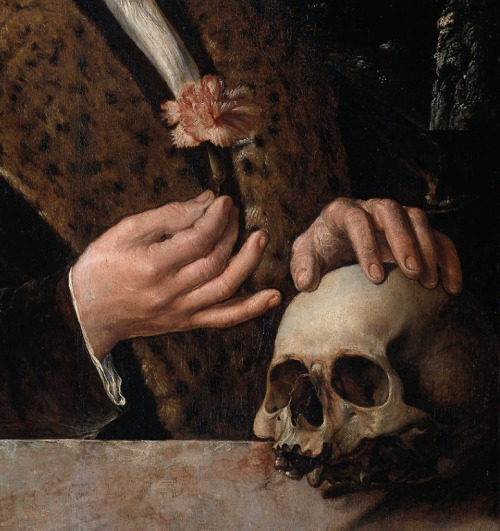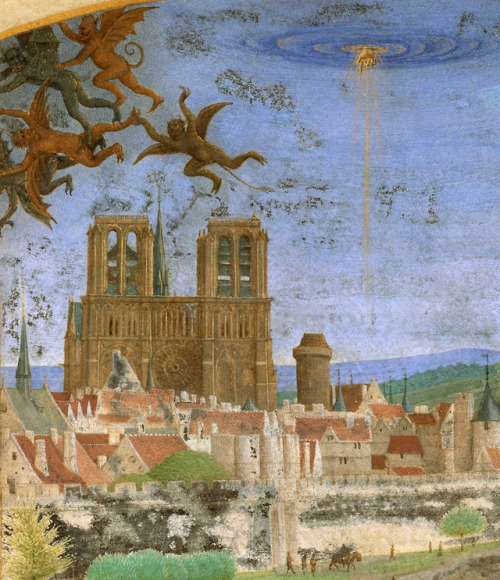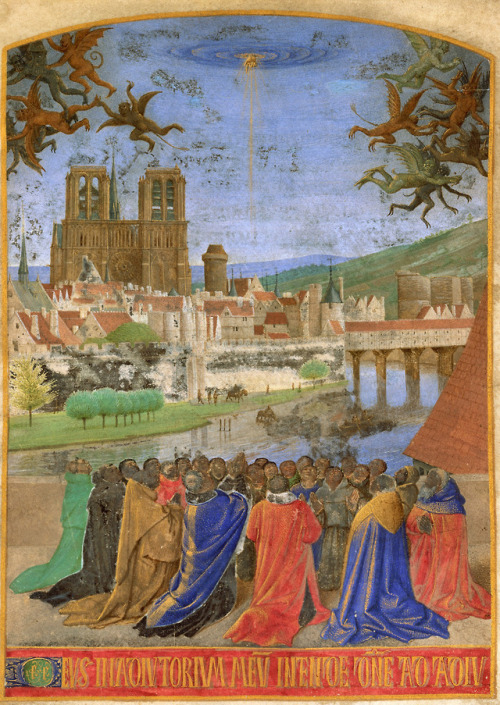Untitled, Nicola Samorì (2012) // Hannibal 3x02


untitled, nicola samorì (2012) // hannibal 3x02
More Posts from Temple-of-bullets and Others

Dirck Jacobsz, Detail of Portrait of Pompeius Occo, 1534


the cathedral
“Hours of Étienne Chevalier”, Tours c. 1452-1460
NY, The Metropolitan Museum of Art, 1975.1.2490




Exhibition quality German hunting knife with chiseled silver mountings and sheath, stag handle. Late 19th or early 20th century.
from Rock Island Auctions
Can you tell me more about fabric flower hair pins used in hanfu? I saw a lot of Japanese-style kanzashi in “The Empress of China”, but I couldn’t find any info of that sort of hair ornament used in Chinese history.
Hi, thanks for the question!

Yep, you’re right - the Cdrama “The Empress of China” sometimes uses Japanese-style fabric flower hairpins (see example below) that are culturally and historically inaccurate (then again, Chinese costume dramas are notorious for being loose with sartorial historical accuracy…):

So let’s now take a look at actual Chinese fabric flower hairpins:

The umbrella term for Chinese flower hair ornaments is Zan Hua/簪花 (lit. “flower hairpins”), which includes fresh flowers as well as artificial ones made from fabric, paper (Zhi Hua/纸花), beads (Zhu Hua/珠花), etc.
Traditional Chinese fabric flower hairpins used with Hanfu include (but are not limited to!):
1) Juan Hua/绢花: “Silk flowers” - flower imitations made from silk fabrics of various colors. Dates back to more than 1,700 years ago, and was the main ornament for women during the Tang Dynasty. In 2008, Beijing Juanhua was officially designated as an intangible cultural heritage of China.


2) Chan Hua/缠花: “Wrapped flowers” - using colorful silk threads to wind flower art onto fixed frames. The technique of wrapping flowers originated during the Ming dynasty and flourished in the Qing dynasty. Notable for being small, delicate, and lifelike. Has been designated as an intangible cultural heritage of China.



3) Rong Hua/绒花: "Velvet flowers” - made from fine silk on twisted wire frames. Dates back to the Qin Dynasty, and was a marker of nobility. Eventually became popular among the common people during the late Ming and early Qing dynasties, and was mainly worn during festivals and weddings. In 2006, Nanjing Ronghua was officially designated as an intangible cultural heritage of China.



For more resources, you can check out my Zanhua tag for my posts on Chinese floral hair ornaments, as well as my sub-tags for Chanhua and Ronghua.
Of course this doesn’t cover everything, but hope this helps! ^^
Sources/Images: 1, 2, 3, 4, 5, 6, 7, 8, 9, 10, 11, 12


Lawrence of Arabia (1962)




It is the future that we bring when tomorrow comes!
if there’s anything i would describe as my aesthetic it would probably be these pictures of the fire









Hannibal (2013-2015)
3x02 - “Primavera”
-
 darknovalatte liked this · 6 months ago
darknovalatte liked this · 6 months ago -
 therolinaarch reblogged this · 11 months ago
therolinaarch reblogged this · 11 months ago -
 maybemathieu liked this · 1 year ago
maybemathieu liked this · 1 year ago -
 kasplonk liked this · 1 year ago
kasplonk liked this · 1 year ago -
 psalm23-6 reblogged this · 1 year ago
psalm23-6 reblogged this · 1 year ago -
 dad-is-on-a-hunting-trip liked this · 1 year ago
dad-is-on-a-hunting-trip liked this · 1 year ago -
 kaisidony liked this · 1 year ago
kaisidony liked this · 1 year ago -
 acursedvalentine liked this · 1 year ago
acursedvalentine liked this · 1 year ago -
 marionete-de-carne reblogged this · 1 year ago
marionete-de-carne reblogged this · 1 year ago -
 qualude reblogged this · 1 year ago
qualude reblogged this · 1 year ago -
 vel-locet reblogged this · 1 year ago
vel-locet reblogged this · 1 year ago -
 faeghouls liked this · 1 year ago
faeghouls liked this · 1 year ago -
 yuureei reblogged this · 1 year ago
yuureei reblogged this · 1 year ago -
 calcified--heart liked this · 1 year ago
calcified--heart liked this · 1 year ago -
 misanthropicvampire reblogged this · 1 year ago
misanthropicvampire reblogged this · 1 year ago -
 monstxrfkr reblogged this · 1 year ago
monstxrfkr reblogged this · 1 year ago -
 violet-roll liked this · 1 year ago
violet-roll liked this · 1 year ago -
 unlivedtenderness liked this · 1 year ago
unlivedtenderness liked this · 1 year ago -
 fionasjoanofarcphotoshoot liked this · 1 year ago
fionasjoanofarcphotoshoot liked this · 1 year ago -
 murraiy reblogged this · 1 year ago
murraiy reblogged this · 1 year ago -
 quartz-is-drawing liked this · 1 year ago
quartz-is-drawing liked this · 1 year ago -
 openuptoeverything reblogged this · 1 year ago
openuptoeverything reblogged this · 1 year ago -
 resideanevil reblogged this · 1 year ago
resideanevil reblogged this · 1 year ago -
 maybe-kilee liked this · 1 year ago
maybe-kilee liked this · 1 year ago -
 dayofrainclaw liked this · 1 year ago
dayofrainclaw liked this · 1 year ago -
 love-songs-for-emma liked this · 1 year ago
love-songs-for-emma liked this · 1 year ago -
 sxartmblr liked this · 1 year ago
sxartmblr liked this · 1 year ago -
 gingerpeachtea reblogged this · 1 year ago
gingerpeachtea reblogged this · 1 year ago -
 gingerpeachtea liked this · 1 year ago
gingerpeachtea liked this · 1 year ago -
 orange-lover liked this · 1 year ago
orange-lover liked this · 1 year ago -
 lesbian-hannibal reblogged this · 1 year ago
lesbian-hannibal reblogged this · 1 year ago -
 senatorq liked this · 1 year ago
senatorq liked this · 1 year ago -
 reallystrangetrash liked this · 1 year ago
reallystrangetrash liked this · 1 year ago -
 helaheim reblogged this · 1 year ago
helaheim reblogged this · 1 year ago -
 cow-pharmacy liked this · 1 year ago
cow-pharmacy liked this · 1 year ago -
 wheezethebluejay liked this · 1 year ago
wheezethebluejay liked this · 1 year ago -
 rhiannoncrystal reblogged this · 1 year ago
rhiannoncrystal reblogged this · 1 year ago -
 rhiannoncrystal liked this · 1 year ago
rhiannoncrystal liked this · 1 year ago -
 epicstageplayer1601 liked this · 1 year ago
epicstageplayer1601 liked this · 1 year ago -
 white-trash-apollo reblogged this · 1 year ago
white-trash-apollo reblogged this · 1 year ago -
 white-trash-apollo liked this · 1 year ago
white-trash-apollo liked this · 1 year ago -
 1ts-cl4ss1f13d reblogged this · 1 year ago
1ts-cl4ss1f13d reblogged this · 1 year ago -
 helena-margaretha liked this · 1 year ago
helena-margaretha liked this · 1 year ago -
 clowndotorg reblogged this · 1 year ago
clowndotorg reblogged this · 1 year ago -
 pretty-face-breaker liked this · 1 year ago
pretty-face-breaker liked this · 1 year ago -
 autisticlegolas liked this · 1 year ago
autisticlegolas liked this · 1 year ago





